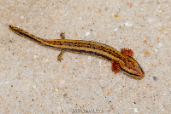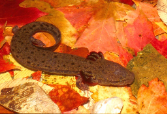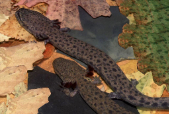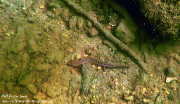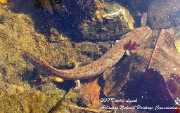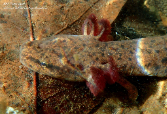 |
Red River Mudpuppy Range Map
|
|
|
 |
 |
 |
 |
 |
 |
|
Red River Mudpuppy (Necturus louisianensis)
Description: It is much different in appearance from the common mudpuppy which is gray to brown, with round blue-black spots. The Red River mudpuppy is light yellowish brown with a white stripe on either side of the middorsal area.
Habitat: Sandy-bottom flowing water
Range: It is found in southeastern Kansas, southern Missouri, northeastern Oklahoma, Arkansas, and northcentral Louisiana. It lives only in the Red River and adjacent drainage systems.
Diet: They are carnivorous creatures and will eat almost anything they can get into their mouths. Typically they prey upon animals such as insects and their larvae, mollusks, annelids, crayfish, small fish, amphibians, earthworms, and spiders.
Reproduction: Mudpuppies take six years to reach sexual maturity. Mating typically takes place in autumn, though eggs are not laid till much later. When males are ready to breed, their cloacae become swollen. Males deposit their spermatophores in the substratum of the environment. The female will then pick them up with her cloaca and store them in a small specialized gland, a spermatheca, until the eggs are fertilized. Females store the sperm until ovulation and internal fertilization take place, usually just prior to deposition in the spring. Before the eggs are deposited, male mudpuppies leave the nest. Once ready, the female deposits the eggs in a safe location, usually on the underside of a rock or log. They can lay from 20 to 200 eggs, usually an average of 60. The eggs are not pigmented and are about 0.20–0.24 inches in diameter. The female stays with her eggs during the incubation period (around 40 days). Hatchlings are about 0.98 inch long and grow to 1.4 inches before the yolk is completely consumed.
Status: Listed as Secure in Arkansas, listed as Vulnerable in Kansas and Louisiana, Listed as Apparently Secue in Missouri, and Listed as "No Status Rank" for Oklahoma,
Taxonomy: Some taxonomic authorities consider this salamander to be a subspecies of the common mudpuppy (N. maculosus) as N. maculosus louisianensis, or the Red River mudpuppy. The Red River waterdog was proposed as a separate species from the common mudpuppy by Collins in 1991 and 1997, but supporting data was lacking. Petranka (1998) and Crother (2000) both treated this animal as a subspecies. Phylogenetic and morphological analyses done by Chabbaria et al. 2018, confirmed them as being distinct species. However, some authorities still keep it as a subspecies.
»» Kingdom: Animalia - Animals
»» Phylum: Chordata - Chordates
»» Subphylum: Vertebrata - Vertebrates
»» Class: Amphibia - (Amphibians)
»» Order: Caudata - Salamanders
»» Family: Proteidae - Mudpuppies & Olm
»» Genus: Necturus
»» Species: Necturus louisianensis - Red River Mudpuppy
This article uses material from the Wikipedia article "Red River waterdog", which is released under the Creative Commons Attribution-Share-Alike License 3.0. Content may have been omitted from the original, but no content has been changed or extended.
|
|


